We booked a limo with our fellow Prescott travelers for the ride to and from the Phoenix airport.
It was wonderful for us to sit back and leave the driving to someone else. Keith and Sara brought a bottle of champagne to share while riding. After a delayed departure from the Phoenix airport that resulted in missing our Zurich connection at Dulles and spending the night at a hotel near the Washington, D.C. airport, we finally arrived in Lucerne a day later than planned and were welcomed with open arms by our friends from Florida and Oregon. It was wonderful to see them again and we reminisced and looked forward to the next three weeks together on our 882.5 mile journey from Switzerland to Belgium, going through 35 locks on the Rhine and Mosel rivers.
again and we reminisced and looked forward to the next three weeks together on our 882.5 mile journey from Switzerland to Belgium, going through 35 locks on the Rhine and Mosel rivers.
I have used a few links to websites for the noted city or point of interest so you can look up additional information if you want to learn more. Here is a photo of our group of thirteen, eight from the Portland, Oregon area, four from Prescott, and one from Florida.
One thing we noticed is that this time of year it stays light later in the evenings than we are accustomed to - it was still light at 9:00 p.m. or later. This made it nice for after dinner walks and walking back to the hotels after dinner.
Lucerne was having a heat wave like they hadn't seen for years, and with the humidity of the area added to the high temps it felt a lot like the midwest where Dale and I grew up ... and reminded us why we love Arizona's mountain weather. We arrived at the hotel, unpacked a 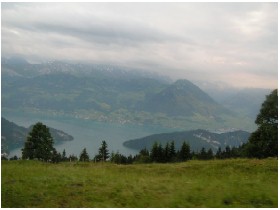 bit and had lunch, then joined our tour group later that afternoon for a relaxing boat ride across Lake Lucerne, passing beautiful sights of mountains and villages surrounding the lake. We then rode a cable car up Mount Rigi while passing over meadows, cows and alpine huts. We had an awesome view of Lake Lucerne, the city of Lucerne and the Alps while on the mountain. We had an appetizer of Swiss fondue followed by dinner. Tradition says that if you drop your bread into the fondue (accidently...or not) you must kiss the person next to you, so choose your dinner companions carefully! Entertainment was provided by three local Swiss folkloric musicians and consisted of a "concert" played on the alphorn with flag waving accompaniment. Several in our tour group tried to make music with the alphorn, others danced or played other instruments at the encouragement of fellow travelers. At the end of the evening we rode a cog rail train back down to the lake where our motorcoach waited to return us to our hotel.
bit and had lunch, then joined our tour group later that afternoon for a relaxing boat ride across Lake Lucerne, passing beautiful sights of mountains and villages surrounding the lake. We then rode a cable car up Mount Rigi while passing over meadows, cows and alpine huts. We had an awesome view of Lake Lucerne, the city of Lucerne and the Alps while on the mountain. We had an appetizer of Swiss fondue followed by dinner. Tradition says that if you drop your bread into the fondue (accidently...or not) you must kiss the person next to you, so choose your dinner companions carefully! Entertainment was provided by three local Swiss folkloric musicians and consisted of a "concert" played on the alphorn with flag waving accompaniment. Several in our tour group tried to make music with the alphorn, others danced or played other instruments at the encouragement of fellow travelers. At the end of the evening we rode a cog rail train back down to the lake where our motorcoach waited to return us to our hotel.
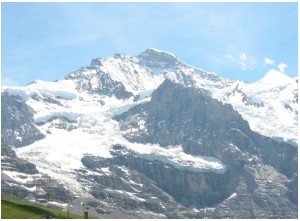 The next morning we rode a motorcoach across the Bruenig Pass to the well-known town of Interlaken where we had time to walk around and see the sights and hone our retail therapy skills before reboarding our coach and continuing to Lauterbrunnen where we boarded a cog train to
Kleine Scheidegg Railway Station, high in the Swiss Alps (6762 ft.). We had a typical Swiss lunch of bratwurst and roesti, with a view of the Eiger, Moench and Jungfrau Mountains out the windows of the restaurant. This area is where the movie "The Eiger Sanction" was filmed. The views from here are incredible! There aren't words to describe the magnificent beauty of this area. While waiting for the
cog train to take us back down the mountain, we could hear cowbells echoing in the distance.
The next morning we rode a motorcoach across the Bruenig Pass to the well-known town of Interlaken where we had time to walk around and see the sights and hone our retail therapy skills before reboarding our coach and continuing to Lauterbrunnen where we boarded a cog train to
Kleine Scheidegg Railway Station, high in the Swiss Alps (6762 ft.). We had a typical Swiss lunch of bratwurst and roesti, with a view of the Eiger, Moench and Jungfrau Mountains out the windows of the restaurant. This area is where the movie "The Eiger Sanction" was filmed. The views from here are incredible! There aren't words to describe the magnificent beauty of this area. While waiting for the
cog train to take us back down the mountain, we could hear cowbells echoing in the distance.
In the morning we walked around Lucerne before leaving for Basel, where we would board our riverboat and spend the next two weeks. 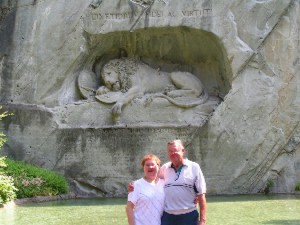 One thing we didn't want to miss is the Lion of Lucerne. It is incredible. For more information, click on the link. We also had time to shop, and wonder of wonders, Jane found a Swiss watch to add to her collection. We walked around Lucerne and had a rather relaxing morning, looking forward to the continuation of our trip to the Netherlands. After arriving in Basel and boarding our riverboat we unpacked and relaxed until dinner, getting to know our new friends from Oregon and reminiscing with "old" friends Tom, Mike and Helen. We were on the same riverboat, the River Symphony, on our first river cruise in 2000 from Amsterdam to Vienna - the trip that got us hooked on riverboat travel in Europe. The next morning we put on our "cobble crushers" (good, sturdy walking shoes for cobblestones) for a walking tour of
Basel, which is situated on the Rhine where Switzerland, Germany and France "touch noses". It is Switzerland's second largest and most wealthy city. Due to its location, influences from both Germany and France make Basel an exciting and varied city. We wanted to buy hand made Swiss chocolates to bring home for friends, but were told by the store owner that we wouldn't be able to get back to the ship before it would be reduced to globs. It was just too hot outside.
One thing we didn't want to miss is the Lion of Lucerne. It is incredible. For more information, click on the link. We also had time to shop, and wonder of wonders, Jane found a Swiss watch to add to her collection. We walked around Lucerne and had a rather relaxing morning, looking forward to the continuation of our trip to the Netherlands. After arriving in Basel and boarding our riverboat we unpacked and relaxed until dinner, getting to know our new friends from Oregon and reminiscing with "old" friends Tom, Mike and Helen. We were on the same riverboat, the River Symphony, on our first river cruise in 2000 from Amsterdam to Vienna - the trip that got us hooked on riverboat travel in Europe. The next morning we put on our "cobble crushers" (good, sturdy walking shoes for cobblestones) for a walking tour of
Basel, which is situated on the Rhine where Switzerland, Germany and France "touch noses". It is Switzerland's second largest and most wealthy city. Due to its location, influences from both Germany and France make Basel an exciting and varied city. We wanted to buy hand made Swiss chocolates to bring home for friends, but were told by the store owner that we wouldn't be able to get back to the ship before it would be reduced to globs. It was just too hot outside.
From Basel we sailed to Strasbourg, France. It is a city in northeastern France and is a strategic river port. There is an incredible number of swans in the rivers and the canals of Strasbourg, and it was fun to watch them. The center of the old city is an island, and some of the canals link the city with the Rhine, Rhone and Marne rivers. The city is famous for pate de foie gras. After a canal ride through the town we had lunch on the riverboat before embarking on the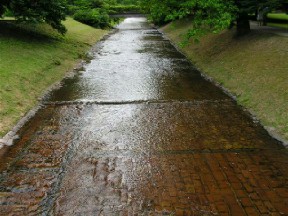 Alsatian Wine Road to Riquewihr (pronounced "rickyweer") On the way to Riquewihr we stopped at a stork farm and saw, ironically, baby storks. Many of the homes along the route to the farm had stork nests on their rooftops, which is said to be a symbol of good luck.
Alsatian Wine Road to Riquewihr (pronounced "rickyweer") On the way to Riquewihr we stopped at a stork farm and saw, ironically, baby storks. Many of the homes along the route to the farm had stork nests on their rooftops, which is said to be a symbol of good luck.
We were docked overnight in Strasbourg and spent the morning sailing the Rhine. After lunch we rode a motorcoach to the famous town of Baden-Baden in the Black Forest. On our walking tour around town we saw a stream that was paved with bricks ... and tasted the natural mineral waters (much more salty than the natural mineral waters in Montecatini, Italy). One gets a very peaceful feeling in this quiet town.
The next day we sailed to the city of Worms, where on our walking tour we learned about the variety of religions in Europe. This city is one of the places that shaped Protestantism when in 1521 Martin Luther defended himself to the Holy Roman Emperor. In the afternoon we had a tour through the scenic German countryside to
Freinsheim, in the heart of the Rhine-Palatine wine region. We were met by the wine grower and rode in a covered wagon through the town and into the heart of the wine fields, stopping to pick cherries off the trees along the side of the road. While riding in the covered wagon we had wine tasting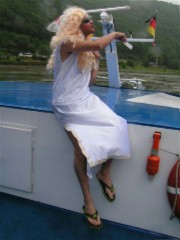 provided by the owner of the vineyard, followed by dessert at his home.
provided by the owner of the vineyard, followed by dessert at his home.
In the morning we sailed past
Lorelei, the monument to the legendary siren who is said to have lured sailors to their death by distracting them with her beautiful voice which sent them crashing into the rocks. We had our very own Lorelei on our riverboat (aka Program Director Rolf) who danced around the ship creating quite a scene. We sailed on to
Boppard where we again donned our cobble crushers for an infostroll around the town.
During the night we turned from the Rhine onto the Mosel River, making a left turn at the German Corner at Koblenz. We spent the full day sailing the beautiful Mosel River Valley admiring how the vintners could raise crops on the steep hills. They do not irrigate, but let nature do the watering for them. We listened to a lecture on German wines as we traveled through the Mosel wine country. There was an amazing number of campgrounds along the rivers, and some people looked settled in for the summer, with full-size refrigerators on the enclosed sunporch of their tent, TV satelite dishes, and huge tents.
We sailed to Traben-Trarbach, where we had an infostroll through these most interesting towns, one on each side of the Mosel River. In the afternoon some of us went on a tour to 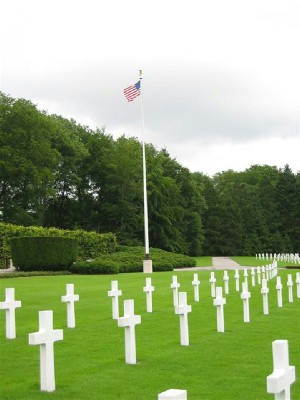 Luxembourg, including the
American Military Cemetery where 5,076 American soldiers are buried with
General George Patton. He died from injuries in a car accident in December 1945, and had requested to be buried with his soldiers. We were at the cemetery on July 4th, and it is a most memorable one for all of us on this tour. At the cemetery is a diagram of that part of WWII, plus two large stone memorials with the names of those buried there, and a small chapel. While we were at the chapel the attendant played our National Anthem over the cemetery's PA system, then the Battle Hymn of the Republic, which left not a dry eye on any of us. It was very moving experience for everyone.
Trier was our next stop on the Mosel River. It is the oldest city in Germany, and in the third millenium BC there were already human settlements here. Karl Marx was born in Trier, and today his birthplace is a museum. From Trier we sailed to Bernkastel where we spent a few hours sightseeing and the ladies found a sidewalk sale. We then went on to Andernach, where evidence has been found of settlement activity as far back as primeval times. The Round Tower is the highest medieval military tower in Germany, and has walls four meters thick. There is a great story in the legend of the
Andernach Baker Boys and the Bees.
Luxembourg, including the
American Military Cemetery where 5,076 American soldiers are buried with
General George Patton. He died from injuries in a car accident in December 1945, and had requested to be buried with his soldiers. We were at the cemetery on July 4th, and it is a most memorable one for all of us on this tour. At the cemetery is a diagram of that part of WWII, plus two large stone memorials with the names of those buried there, and a small chapel. While we were at the chapel the attendant played our National Anthem over the cemetery's PA system, then the Battle Hymn of the Republic, which left not a dry eye on any of us. It was very moving experience for everyone.
Trier was our next stop on the Mosel River. It is the oldest city in Germany, and in the third millenium BC there were already human settlements here. Karl Marx was born in Trier, and today his birthplace is a museum. From Trier we sailed to Bernkastel where we spent a few hours sightseeing and the ladies found a sidewalk sale. We then went on to Andernach, where evidence has been found of settlement activity as far back as primeval times. The Round Tower is the highest medieval military tower in Germany, and has walls four meters thick. There is a great story in the legend of the
Andernach Baker Boys and the Bees.The three program directors who were with us offered a prize to the person who found the longest German word. The winner had to try to pronounce it, and had to know the meaning of it. This was the winner:
DONAUDAMPFSCHIFFAHRTSELEKTRIZITAETENHAUPTBETRIEBSWERKBAUUNTERBEAMTENGESELLSCHAFT
 Andernach was our last city in Germany, and as we sailed on to the Netherlands we passed the Bridge at Remagen. (At this link, click on the History of the Bridge link). The Ludendorff Bridge at Remagen was built during the First World War at the urging of the German generals, so that more troops and war materials could be brought to the Western Front. The railway bridge was designed by Karl Wiener, an architect from Mannheim. It was 325 meters long, had a clearance of 14.80 m above the normal water level of the Rhine, and its highest point measured 29.25 m. The bridge carried two rail lines and a pedestrian walkway. It was considered one of the finest steel bridges over the Rhine. Very little is left of this landmark, but there is a museum housing artifacts and information.
Our first port in the Netherlands was Nijmegen (pronunced "nidjmiyen"), on the Wahl River. We had a guided walk around the town, and then a home-hosted lunch. Many of the homes have their front door and windows painted bright, cheery colors, which adds to the uniqueness of this small town. In the afternoon we went to see the windmills of Kinderdijk, a UNESCO World Heritage Site. It is a most fascinating area with 19 windmills built around 1740.
Andernach was our last city in Germany, and as we sailed on to the Netherlands we passed the Bridge at Remagen. (At this link, click on the History of the Bridge link). The Ludendorff Bridge at Remagen was built during the First World War at the urging of the German generals, so that more troops and war materials could be brought to the Western Front. The railway bridge was designed by Karl Wiener, an architect from Mannheim. It was 325 meters long, had a clearance of 14.80 m above the normal water level of the Rhine, and its highest point measured 29.25 m. The bridge carried two rail lines and a pedestrian walkway. It was considered one of the finest steel bridges over the Rhine. Very little is left of this landmark, but there is a museum housing artifacts and information.
Our first port in the Netherlands was Nijmegen (pronunced "nidjmiyen"), on the Wahl River. We had a guided walk around the town, and then a home-hosted lunch. Many of the homes have their front door and windows painted bright, cheery colors, which adds to the uniqueness of this small town. In the afternoon we went to see the windmills of Kinderdijk, a UNESCO World Heritage Site. It is a most fascinating area with 19 windmills built around 1740.
Our next port stop was Veere (pronounced "veera"), which is really more of a village than a town. We were very fortunate to be there on the day of an annual Medieval festival with contestants dressed in Medieval clothing participating in a Ringrijder contest that lasted the better part of the day. First we had a walking tour of this quaint and interesting town, then in the small main square many of us watched the contest. The carriage riders are called Sjezenrijers,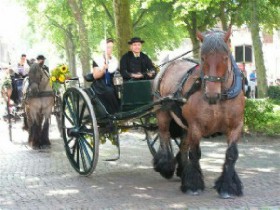 and are pulled by a team of huge horses. The men driving the carriages wear era tuxedos and their ladies wear period clothing and ride through the street where rings were hung from cables stretched across the street about an arm's length above the carriages. The distance of the course was about 100 yards, and the ladies had to spear a ring at the beginning and at the end of each round, all while the horses were trotting on the cobblestone street. After each round the ring was replaced by a smaller ring. When they took their breaks, some of the carriage drivers would give rides to "civilians" who wanted to try to spear the ring. Dordis and Jane tried and missed, as did one of our fearless leaders, Rolf (aka Lorelei). It was fun to try, however. I wanted to put a link in here for more information, but all the articles are in Dutch.
and are pulled by a team of huge horses. The men driving the carriages wear era tuxedos and their ladies wear period clothing and ride through the street where rings were hung from cables stretched across the street about an arm's length above the carriages. The distance of the course was about 100 yards, and the ladies had to spear a ring at the beginning and at the end of each round, all while the horses were trotting on the cobblestone street. After each round the ring was replaced by a smaller ring. When they took their breaks, some of the carriage drivers would give rides to "civilians" who wanted to try to spear the ring. Dordis and Jane tried and missed, as did one of our fearless leaders, Rolf (aka Lorelei). It was fun to try, however. I wanted to put a link in here for more information, but all the articles are in Dutch.
We arrived in Antwerp the next morning and set off on a walking tour of the city. Antwerp's Old Town is built around the Grote Markt (town square) and has beautiful Guild Houses. Artist Paul Rubens purchased a 16th century house here when he moved from Italy in 1608, and today it is a museum. This was packing day, as we were disembarking in the morning. After breakfast we left by motorcoach for Brugge, our 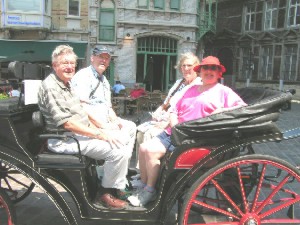 home for the next three days. En route we stopped at
Ghent, founded around 600 at the confluence of the Schelde and Leie Rivers. In the city's Pacification Hall the Treaty of Ghent was signed in 1814, ending the War of 1812. Some of us chose to take a carriage ride around the town. After lunch we happened upon a chocolate shop we couldn't resist, so bought some handmade Belgium chocolates for dessert - the best in the world!
home for the next three days. En route we stopped at
Ghent, founded around 600 at the confluence of the Schelde and Leie Rivers. In the city's Pacification Hall the Treaty of Ghent was signed in 1814, ending the War of 1812. Some of us chose to take a carriage ride around the town. After lunch we happened upon a chocolate shop we couldn't resist, so bought some handmade Belgium chocolates for dessert - the best in the world!
After arriving in the Medieval town of Brugge and settling into our hotel we went on a guided vicinity walk around the hotel area. Brugge is the former capital of Flanders and is still defined by its canals, often being referred to as the Venice of the North. In the morning a local guide took us on a walking tour, giving us a history lesson of Brugge, and at the end of the tour we boarded a boat for a canal cruise through this living museum of a town. Many of the homes were built between the 13th and 15th centuries by wealthy textile merchants. We found an outdoor restaurant on the square serving Belgium waffles, so stopped for lunch before shopping for chocolate and handmade lace.
The next day some of us rode a paddle wheel boat on the canal from Brugge to the village of Damme, which borders the North Sea. It's a quaint little town where we had lunch and walked around a bit before catching the boat for the four-mile ride back to Brugge. It was a beautiful, relaxing way to end our trip before having to pack and prepare for our long trip home.
After having a farewell dinner with our group the last evening we would be together, we said our goodbyes, as some were leaving at oh-dark-thirty in the morning before the rest of us were awake. We hope you enjoyed your virtual trip from Switzerland to Belgium.
Return to
Jane & Dale's Home on the Web